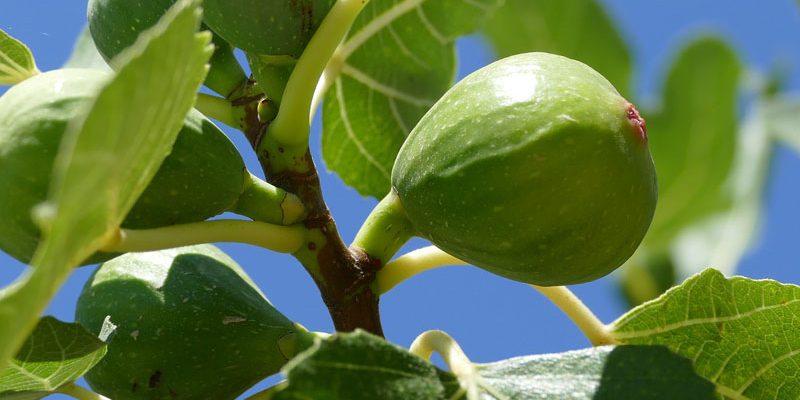If you’d like to know how to grow a fig tree in Arizona, this post is for you! Growing a fig tree can be really rewarding. They are able to grow two harvests during a single growing season, are quite beautiful, and the produce really sweet fruit. A fig tree can take more than 3 years to be able to produce a viable crop, but when it finally does you can have all the figs that you can eat.
Figs are also one of the oldest cultivated crops and not to mention that they were a favorite for some of the oldest societies. The ancient Egyptians, Greeks and Romans enjoyed figs. A fig tree can grow between 10 feet to 30 feet tall and they have leaves that make them look really tropical. The common fig tree will be deciduous, so the leaves will come off during the fall season. All of the flowers on the fig tree are female, so it does not need pollination to produce fruit. This means bigger crops without having to rely on pollination.
Picking a fig tree:
Many fig tree types will grow anywhere. However, some will do better in a dry, hot climate such as in Mesa, Arizona. The Kadota and Conadria fig trees are two that do really well in the Arizona heat.
Kadota Fig
These will produce a large to medium sized fruit. The fruit will be yellow, and it is really sweet. The fruit from this fig tree will ripen best in a hot temperature area and in full sun. The Kadota fig tree is grown extensively and it is the most common fig type that you will find in a local grocery store.
Conadria Fig
These are the largest fig trees and it will have a very high sugar content. The fruit that is produced can be used to eat fresh or it makes a really great dried fruit. This fig also resists spoiling during rainy weather and has a small eye size. This helps with insect resistance.
How Big Do Fig Trees Get?
Fig trees grow rather quickly and will end up around 25 feet tall. They also grow in width to about the same size as they are tall. Plan this into the location you choose for your fig tree. Don’t plant it in a spot where the full grown tree won’t fit well aesthetically or near power lines. Fig leaves are also quite large, sometimes reach as much as 10 inches in length and width. With leaves this large there’s no surprise that the fig tree is beloved for it’s fruit and the shade it provides.
Planting Fig Trees in your Backyard
There are normally two cycles of harvesting figs in a single year. The first crop is called breba. This is a crop that is basically the maturation of any previously growing buds. The crop after it is actually the main crop, and this is where the fruit develops which is during spring and summer.
Picking a location:
Depending on the fig tree that you get, you will have to consider the width where you will be planting the tree. A fig tree can grow quite large which can span between 10 feet to 30 feet. They can even be much wider than they are tall. Another thing to consider when picking where to plant your fig tree is that leaves do drop. The fig is deciduous and if you have a pool then you want to plant the tree as far away from the pool as possible or place it in the front yard. Fig trees require between 8 to 10 hours of full sun per day, so you will want to keep the fig tree away from the house or where I may be shaded. You also will need soil that drains quite well and sandy soils are best for a fig tree.
Planting A Fig Tree:
Just like with other trees that you want to plant within the desert, the time to plant a fig tree will be in the early spring or fall. This will give the root system a bit of time to mature and be ready for harsh summer weather that happens in Arizona.
Water a Fig Tree:
During the average summer heat in Arizona, a fig tree will need to be watered every 3 to 5 days. If it is really hot and Arizona has set heat records, then water more often than that. If you are unsure if you tree needs to be watered, you can use a soil probe to find out. All trees will need to be watered to 3 feet each time that there is an irrigation event. There is not a set rule for how much water it will take to reach 3 feet because different soil types will take different times.
Fertilizing the Fig Tree:
Most times fig trees that have been planted directly into the ground will not have a need for fertilization. The big exception is if they get planted in sandy soil. If you are unsure if the soil has the right nutrients, then you can have the soil tested by a lab. If the soil is deemed to be low in nutrients, then get a half a pound of nitrogen and then divide it into 3 different treatments. Apply the nitrogen during the months of growth which are May – June -July.
Pruning a Fig tree:
One of the best parts about growing a fig tree is that it hardly needs to be pruned. They only produce 2 crops during a single growing season and it is best that they get pruned after the second harvest. If you wait and then try to prune the fig tree during winter, then you risk removing some of the fruit that is already growing which would be part of your next harvest.
Fig Tree Pests:
Luckily, within Arizona there are not as many pests as in other areas of the United States. There are three common pests that you may deal with when it comes to your fig tree. Gophers, green fig beetle and birds are very common for Arizona. In order to protect your fruit from birds and beetles, then you can cover the fruit with netting or bagging. There is very little to be done about gophers.
What do you do with figs?
There are many fig tree owners that are really surprised with just how much fruit is produced once the tree has matured properly. It does take a couple of years after it is planted to get the tree to produce its first fruit. However, whenever it starts to get going, it really goes. Most owners scramble to hurry up and begin making jam, but the truth is there are a lot of things to do with figs.
What does a fig taste like?
There are a lot of varieties for fig trees and that means there are many flavors. A few of the most popular figs that are well known in a pantry are: King Figs, Calimyrna, Kadota, Sierra, Black Mission and Brown Turkey. The flavors can really vary from being similar like a raspberry to an almond and honey to caramel to maple syrup to a nutty caramel coffee type of flavor.
Here are a few ways that you can enjoy figs:
Put figs in batter: Whenever you are making scones, cookies or muffins, throw some figs into the batter. This will add a delicious and unique flavor. It will also set your treats apart and give them a unique taste that everyone will love.
Add them to your meat: When you are cooking a roast for a holiday or even just a weekend meal, throw a few figs in with your meat. While the cook, they will start to release a delicious aroma and slowly release their savory juices into the sauce.
Fig Chutney: Take some figs and then simmer them with Thyme. After a bit add some caramelized onions to make a rich fig chutney. This can be a great addition to cheese and cracker platters to add a bit of variety and depth.
Fig Trees For Sale
If you live in Mesa, Queen Creek, or Gilbert; A&P Nursery is your local nursery option that carries the finest fig trees in Arizona. We grow all of our fig trees right here in in the valley so they’re already acclimated to the soil, sun, and heat of our beloved valley. For more information about purchasing a fig tree either swing by 1 of our 4 locations in the East Valley or call 480-892-7939.







